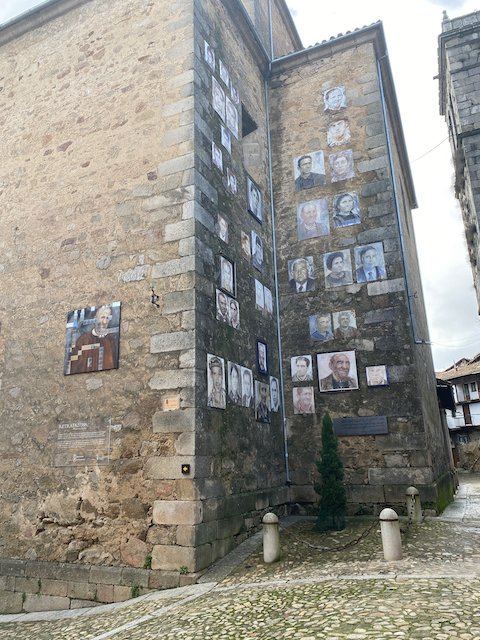The tiny alpine village was tucked into a hillside in the mountains outside of Salamanca, Spain. Water spilled down the sierra from all directions, its distant sound the only one to be heard. The cobblestone streets were unimaginably narrow and we didn’t dare turn our rented Fiat down their entrapping corridors. We parked on the road above and ambled down the quiet, meandering passages towards the town center, the town’s cats ignoring our advances all the while.
As we passed by doorways framed in ancient timbers, faces began to peer at us from all angles. Villagers, both past and present, loomed above us, their heads immense and unmoving, their eyes seeming to follow our every boisterous step in the morning silence. We were being watched.
But these gazes didn’t come from curious locals perched on their porches. The faces were painted on large metal sheets and secured to the facades of seemingly every building. Some had multiple faces; a church in the center had dozens. Every turn through the maze-like corridors revealed a new set of faces, their expressions hiding a million stories of love lost and found, work completed, laughter shared and sadness endured. A married couple poses with a sly grin on the man’s face. An older man looks on with knowing eyes. A young beauty looks up coquettishly, her eyes bright as the morning sun. These are but a few of the 809 haunting portraits of Mogarraz.
Back in 1967, this region of Spain was experiencing an economic downturn. The citizens of Mogarraz were left to search farther afield to find work and, in order to do so, they needed fresh identification papers. In stepped local photographer Alejandro Martín Criado. He offered low-cost portraits to his neigbors to help them get their national identity cards, saving them the hours on the the bus to the nearby city of Salamanca. He ended up taking 388 portraits of his fellow villagers. Afterwards, he put the negatives into a box and they were all but forgotten.
Fifty years later, local artist Florencio Maíllo discovered these negatives and was intrigued by the stories they told. Their vintage, narrative quality was unmistakable and they inspired him to paint the portraits on large sheets of metal and hang them on the facades of the village’s charming medieval buildings. He eventually expanded the series to include portraits of more recent residents, each individual rendered in loose, expressive strokes giving them a lively energy. They are proud of their perch on the streets of Mogarraz, keeping an eye on the locals and visitors alike.
Las Caras de Mogarraz (The Faces of Mogarraz) are an absolute delight to encounter. The outdoor gallery they create adds a distinct sense of otherworldliness as you stroll through the enchanting streets of this tranquil alpine village. It is a very personal and very genuine way to encounter the lives of those that walked these same corridors decades earlier. Their tangible presence creates a lovely haunting aura that is hard to describe in words. It is just one of those places that is like no other.
It’s not hard to see why we were so enchanted by Mogarraz during our time there this past January. To see another artist taking inspiration from everyday people of the past and turning that into a distinctly powerful body of work was inspiring to say the least. Las Caras de Mogarraz speak to the power of public art and its ability to create a unique and accessible experience for those willing to make the pilgrimage. They also showcase the power of stories: the stories we assume about others, the stories we tell ourselves, and the stories we choose to pass on to the next generation.
As we headed up the hill to our trusty Fiat Panda, the cats continued ignoring us with indifference. The hundreds of faces watched us go too, keeping watch over Mogarraz until the next unsuspecting visitors step into its storied streets.







